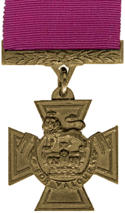Frederic Brooks Dugdale
Frederic Brooks Dugdale | |
|---|---|
 | |
| Born | 21 October 1877 Burnley, Lancashire |
| Died | 13 November 1902 (aged 25) Charingworth, Gloucestershire |
| Buried | Longborough Churchyard |
| Allegiance | |
| Service | |
| Years of service | 1899 - 1902 |
| Rank | Lieutenant |
| Unit | 5th Lancers |
| Battles / wars | Second Boer War |
| Awards | Victoria Cross |
Lieutenant Frederic Brooks Dugdale VC (21 October 1877 – 13 November 1902) was an English British Army officer and recipient of the Victoria Cross, the highest and most prestigious award for gallantry in the face of the enemy that can be awarded to British and Commonwealth forces.
Biography
Dugdale was born in 1877, the youngest son of Colonel James Dugdale, of Sezincot, Moreton in the Marsh, Gloucestershire. He was commissioned into the British Army as a second-lieutenant in the 5th Lancers in October 1899. The outbreak of the Second Boer War the same month saw the regiment sent to South Africa, where they took part in the Ladysmith Relief Column. He was promoted to the rank of lieutenant in May 1900.[1]
He was 23 years old serving during the Second Boer War when the following deed took place on 3 March 1901 near Derby, South Africa for which he was awarded the Victoria Cross.
On 3rd March, 1901, Lieutenant Dugdale, who was in command of a small outpost near Derby, having been ordered to retire, his patrol came under a heavy fire at a range of about 250 yards, and a Sergeant, two men, and a horse were hit. Lieutenant Dugdale dismounted and placed one of the wounded men on his own horse; he then caught another horse, galloped up to a wounded man and took him up behind him, and brought both men safely out of action.[2]
He had a severe attack of enteric fever, and after his recovery served with General John French in the Cape Colony.[1] Staying with his regiment in South Africa until the war ended in May 1902, he then left for the United Kingdom on the SS Briton two months later.[3] Shortly after his return, he was killed in a horse riding accident whilst riding with the North Cotswold Hounds, near Charingworth, Gloucestershire, England, on 13 November 1902.[1] He was buried at Longborough, near Moreton in Marsh.
The medal
His Victoria Cross is displayed at The Queen's Royal Lancers and Nottinghamshire Yeomanry Museum, Thoresby Park, Nottinghamshire, England.
See also
References
- ^ a b c "Obituary". The Times. No. 36925. London. 14 November 1902. p. 8. template uses deprecated parameter(s) (help)
- ^ "No. 27356". The London Gazette. 17 September 1901. p. 6101.
- ^ "The Army in South Africa - Troops returning home". The Times. No. 36821. London. 16 July 1902. p. 11. template uses deprecated parameter(s) (help)
- Monuments to Courage (David Harvey, 1999)
- The Register of the Victoria Cross (This England, 1997)
- Victoria Crosses of the Anglo-Boer War (Ian Uys, 2000)
External links
- Location of grave and VC medal (Gloucestershire)
- Brief biography
- Biography from angloboerwar.com
- 1877 births
- 1902 deaths
- People from Burnley
- Deaths by horse-riding accident
- 5th Royal Irish Lancers officers
- Second Boer War recipients of the Victoria Cross
- British recipients of the Victoria Cross
- Accidental deaths in England
- People educated at Marlborough College
- Alumni of Christ Church, Oxford
- British Army personnel of the Second Boer War
- British Army recipients of the Victoria Cross
